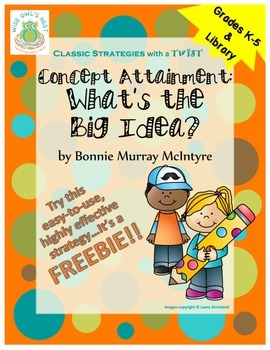Concept Attainment: What’s the Big Idea? -lessons, posters, printables, strategy
1,484 Downloads
Bonnie Murray McIntyre - Wise Owl's Nest
65 Followers
Grade Levels
1st - 5th
Subjects
Resource Type
Standards
CCSSRI.2.3
CCSSSL.3.1d
CCSSSL.3.2
CCSSSL.4.1d
CCSSSL.5.1d
Formats Included
- PDF
Pages
31 pages
Bonnie Murray McIntyre - Wise Owl's Nest
65 Followers
Description
Try this fun, effective teaching strategy that masquerades as a game but involves students in developing a deep understanding of concepts across the curriculum. This free eBook includes:
*Scripted examples that model the strategy in primary and intermediate classrooms;
*Directions for use in grades K, 1, 2, 3, 4, 5, and beyond;
*My special “twist” on the strategy…a learning activity on using mistakes to create success (lesson, worksheet, posters);
*All printables and graphics for implementing the strategy;
*Sample concept attainment lists for math, English language arts, science, and geography (social studies);
*How to develop your own concept attainment lists;
*How to assess students with What’s the Big Idea?;
*Correlation of this brain-compatible strategy with Common Core State Standards (CCSS), Next Generation Science Standards (NGSS), DOK, and Bloom’s.
NOTE: I have used concept attainment successfully for 27 years, and I believe this eBook will help you and your students love it as much as I do. Try this fabulous freebie and let me know what you think! Blessings, Bonnie Murray McIntyre
*Scripted examples that model the strategy in primary and intermediate classrooms;
*Directions for use in grades K, 1, 2, 3, 4, 5, and beyond;
*My special “twist” on the strategy…a learning activity on using mistakes to create success (lesson, worksheet, posters);
*All printables and graphics for implementing the strategy;
*Sample concept attainment lists for math, English language arts, science, and geography (social studies);
*How to develop your own concept attainment lists;
*How to assess students with What’s the Big Idea?;
*Correlation of this brain-compatible strategy with Common Core State Standards (CCSS), Next Generation Science Standards (NGSS), DOK, and Bloom’s.
NOTE: I have used concept attainment successfully for 27 years, and I believe this eBook will help you and your students love it as much as I do. Try this fabulous freebie and let me know what you think! Blessings, Bonnie Murray McIntyre
Total Pages
31 pages
Answer Key
Included
Teaching Duration
N/A
Last updated Feb 3rd, 2015
Report this resource to TPT
Reported resources will be reviewed by our team. Report this resource to let us know if this resource violates TPT’s content guidelines.
Standards
to see state-specific standards (only available in the US).
CCSSRI.2.3
Describe the connection between a series of historical events, scientific ideas or concepts, or steps in technical procedures in a text.
CCSSSL.3.1d
Explain their own ideas and understanding in light of the discussion.
CCSSSL.3.2
Determine the main ideas and supporting details of a text read aloud or information presented in diverse media and formats, including visually, quantitatively, and orally.
CCSSSL.4.1d
Review the key ideas expressed and explain their own ideas and understanding in light of the discussion.
CCSSSL.5.1d
Review the key ideas expressed and draw conclusions in light of information and knowledge gained from the discussions.





